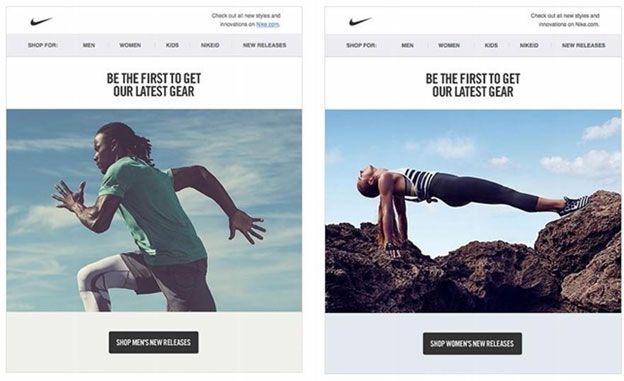Dynamic content is closely related to personalization. It provides its most visual implementation. Being changeable content (text, image, video), it is able to adapt to the priorities and characteristics of the user. This is probably why 65% of marketers consider it the most effective personalization solution.
Therefore, we decided to tell you how to implement dynamic content. Next, you’ll learn how to integrate it into email marketing to improve campaign performance.
Stages of creating a dynamic email
Dynamic content can dramatically increase the effectiveness of email marketing. However, only if it is correctly executed. It also requires compliance with the goals of the advertising campaign. This is quite easy to achieve. It is enough to follow the sequence of steps for introducing dynamic content.
Stage 1: defining the mailing segments
It is important to understand the purpose of using a particular dynamic element. It is also necessary to ensure that the content matches the preferences of the recipient. Accordingly, you should understand who will open the letter.
Information about the audience will help determine the target user. The easiest way to get it is from a CRM site. You can also use social media data and machine learning tools.
For effective and deep segmentation, it is worth considering the following information about users:
- name;
- age (date of birth) and gender;
- location;
- profession (industry and position held);
- income level;
- marital status, as well as the presence/absence of children;
- previously purchased/viewed products;
- individual preferences;
- life cycle stage;
- user-behavior (on the site and in previous mailings).
Information is a valuable resource. However, only if it is relevant. Developing a strategy or advertising campaign based on outdated data will lead to poor marketing performance.
Therefore, constantly update information about users. You can also drill down on the data. For example, by conducting surveys via emails.
Stage 2: choose which email elements will be dynamic
In order for this step not to take much time, we recommend starting from the technical classification of dynamic content. According to her, there are only two types:
- Substituted variables. Such content is adjusted according to the characteristics of the recipient. The most common example of variable substitution is changing the name and/or location.
- Inserted content. Allows you to make personalization deeper. In this case, not only the name of the recipient or the name of the city changes, but also various components of the filling of the letter. For example, paragraphs of text or images. Also, content insertion allows you to implement multilingual email newsletters.
The choice of elements that will be dynamic depends on the distribution tasks. Let’s say a company changes its Privacy Policy and decides to notify users about it. In such a case, variable substitution is appropriate. It will allow you to address each person personally.
However, a sportswear store should opt for content insertion. Then the company can reach out to men and women separately. By the way, the Nike brand has already implemented this idea. Three elements are dynamic here:
1. Image.
2. Text.
3. Call to action.

Don’t forget that content is about quality. Make sure that there are no mistakes or typos in the texts. This will help to improve the content significantly and form a positive image.
Stage 3: check if the display is correct
Dynamic elements can be different. The simplest ones are the recipient’s name, or the text on the call-to-action button. More complex ones can be personalized surveys or special product catalogs for the user.
The more complex the dynamic content, the higher the potential value to the recipient. However, this is provided that the modified element is seen. This is influenced by the capabilities of the mail client.
Research this issue before launching an email newsletter. Often, email clients provide publicly available information about the supported functions.
What if not all dynamic elements are able to render? The first option is to use simpler content. The second is to set up mail for people using certain email clients or devices.
5 email ideas with dynamic content
Personalized recommendations based on preferences
Dynamic content allows you to tailor offers to the individual preferences of a particular user. For this, data processing technologies are used, as well as machine learning. By collecting and analyzing information about each user, the tool offers products that are most likely to resonate with a person.
What tools allow you to do this?
- Esputnik.
- Mailchimp.
Also, some of the email software on this list allow you to do this as well.
Life Cycle Sentences
The motives, fears, and benefits of working with the company differ among new and loyal customers. Loyal customers provide most of the income. However, it is important to set up communication with a person properly in order to guide him through all stages of the life cycle smoothly.
The simplest solution is to segment your customers into two groups. However, allocating more segments will allow for a more personalized experience. RFM analysis helps to achieve this. It is run by one of the aforementioned email newsletter services, Esputnik.
Location-based personalization
Especially relevant for companies operating in different countries. Let’s say an organization sells clothes. The climates of Norway and Mexico are very different. Therefore, a light shirt will be irrelevant to one user, and desirable for another. Dynamic content will allow you to personalize offers accordingly.
Cross-selling
In part, this solution is a continuation of the idea with personalized suggestions. Only here you increase the number of purchases through additional products.
Let’s imagine that there is an online equipment store. The client bought a smartphone there. A company may send an email suggesting products that would make the gadget more convenient to use. For example, headphones, wireless charger or carrying case.
Countdown timer
An element is a form of FOMO marketing implementation. It is actively used when you need to stimulate the user to buy, causing fear of losing a great opportunity. This feeling is a great stimulus for buying.
FOMO marketing is actively used on Black Friday and pre-holiday periods. In particular, it is implemented with a countdown timer. You can enhance the effect of the letter by adding a limited number of products.
Dynamic content in such emails will allow you to implement several incentives at once:
- Limited time offer.
- Limited stock of products.
- Personalized products.
Conclusions
Dynamic content is gaining popularity due to its exceptional flexibility. It allows you to make each contact with the user personalized, showing the company’s attentiveness to the person’s priorities. This is a great start to a client relationship. 72% of shoppers only interact with brands that offer personalized content. Now you can be one of them.

Namaste UI collaborates closely with clients to develop tailored guest posting strategies that align with their unique goals and target audiences. Their commitment to delivering high-quality, niche-specific content ensures that each guest post not only meets but exceeds the expectations of both clients and the hosting platforms. Connect with us on social media for the latest updates on guest posting trends, outreach strategies, and digital marketing tips. For any types of guest posting services, contact us on info[at]namasteui.com.

